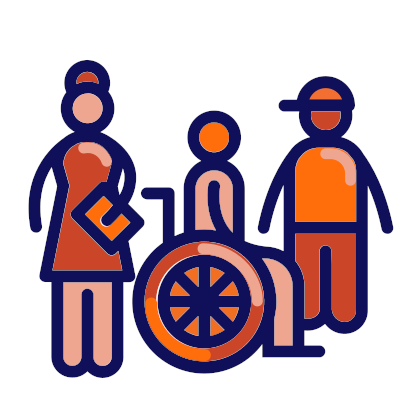Preventing bullying and violence

Schools can, and should, play a key role in tackling these abuses.
Whole-school anti-bullying programmes are needed, which promote peer support systems and involve active and well-trained teachers and parents, to foster a safe learning environment in which no violence is allowed.
Facts & figures
Half of the world’s students aged 13-15 say they have experienced violence in and around school.[1]
Nearly one in three students of this age say they have experienced bullying or been involved in fights.[2]
More than 700 million children have no legal protection from corporal punishment at school.[3]
What is violence and bullying?
Violence is the threatened or actual use of physical force or power resulting in physical or psychological harm to others.
Bullying is a form of violence. It can be defined as unwanted, aggressive behaviour which involves a real or perceived imbalance of power. It is behaviour that is repeated, or carries the threat of being repeated over time.
Bullying takes different forms in school, including:
- Physical, e.g., hitting, kicking, slapping, shoving, hair-pulling, etc.
- Verbal, e.g., name-calling, teasing, using belittling expressions, etc.
- Relational, e.g., ostracising, spreading rumours, social manipulation, etc.
- Sexual, e.g., sexual name-calling, uninvited touching, propositioning, etc.
Cyberbullying is a distinctive form of bullying. It differs from other types on account of the constant risk of public exposure, the complex roles of observers and the size of the audience that comes with digital technologies.[4].
Bullying is not the only form of student-on-student violence in schools, however. Fights between, and attacks on students associated with gang culture and the carrying of weapons, especially knives, are becoming an increasing problem in various countries.
Why is addressing violence and bullying important at school?
Under the U.N. Convention on the Rights of the Child, schools have a formal duty to protect children from all forms of violence, both physical and psychological.
“Parties shall take all appropriate legislative, administrative, social and educational measures to protect the child from all forms of physical or mental violence, injury or abuse, neglect or negligent treatment, maltreatment or exploitation, including sexual abuse, while in the care of parent(s), legal guardian(s) or any other person who has the care of the child.”[5]
Failure to protect children at school can have harmful repercussions on their future lives, both educationally and socially - whether they be victims, perpetrators or bystanders.
Students who are bullied are more likely to suffer from depression and anxiety, health issues, poor academic achievement and behaviour problems at school, including higher drop-out rates. A small number may also retaliate in violent ways. Students who bully others are more likely to exhibit other behaviour problems at school and to suffer from alcohol or drug abuse, and to engage in criminal activity and abusive relationships in adulthood. Children who witness bullying and violence are also more likely to have mental health difficulties and miss or drop out from school.
Violence and bullying not only affects academic learning, it also impacts negatively on the social development of young people. In particular, students who experience violence and bullying are more likely to have difficulty developing basic democratic competences, such as empathy, respect for others, openness to other cultures and beliefs, tolerance of ambiguity and self-efficacy – all of which lie at the heart of the Council of Europe Reference Framework of Competences for Democratic Culture.
The effects of violence and bullying are not limited only to the students directly involved, but potentially impact on everyone at a school. Unchecked, incidents of violence and bullying lead to an atmosphere of anxiety and insecurity incompatible with learning. They also lead to, or exacerbate conflicts beyond the school gates, which in turn have further consequences for relations within the school.
What are the challenges?
Violence and bullying can be challenging to deal with at school. What is regarded as bullying or violence is sometimes thought of as a matter of subjective opinion. It can be difficult to build a common approach to eradicating from school something which a significant proportion of staff believes not to exist or is not important to them.
The prevailing culture in a school can sometimes work against attempts to reduce violence in its different forms. Rule by fear, over-emphasis on punishment and the prioritization of learning environments which support competitive behaviour all militate against the prevention of violence and bullying. So, too, does the holding of an ideology which accepts violence as a valid response in situations of fear, stress or frustration – as evidenced in the advice commonly given to victims of bullying to fight back and give the bully a ‘taste of their own medicine.’
In such circumstances it can be easy to think that dealing with violence and bullying is simply a matter of stopping fights, giving punishments and imposing order, rather than questioning the wider culture of the school, the examples it sets and the sorts of behaviour it supports.
Many teachers are unaware of democratic approaches of dealing with violence and bullying, such as:
- restorative justice
- conflict resolution
- peer mediation.
Such approaches are not only arguably more effective than punitive ones, but also have the advantage of promoting democratic values and attitudes more widely across a school.
Such approaches take time to learn, however, and require the development of specific types of skills, knowledge and attitudes. They also take time to put into practice. It can be difficult for a teacher to find the time and motivation to deal with violence and bullying in a democratic and constructive way. It is easier just to punish the supposed perpetrator, and easier still to pass the perpetrator up the school hierarchy for a more senior member of staff to punish.
A further challenge in recent years has been the rise of gang culture among young people and the carrying of weapons, especially knives, in as well as out of school. This has led to a rise in the number of serious acts of violence between students and also to the more regular involvement of the police in school affairs, both of which demand new professional skills and ways of working from teachers and school leaders.
How can schools get active?
Taking action on violence and bullying is not just a matter of finding better ways of responding to incidents after they have occurred – though this is important, but also of creating the kind of school environment in which violent incidents are less likely to happen in the first place.
A good place to start is with asking students to review the current situation in their school:
- where they feel vulnerable or in danger
- where they feel safe
- what sorts of violence they have witnessed or experienced
- what they see as the causes of these sorts of violence
- how effective they think the school is at dealing with violence
- what further measures they would like the school to take.
Surveying student opinion provides a good evidence base for targeting measures to prevent violence, e.g., increasing supervision in areas in school where students are fearful of going, creating more opportunities for constructive play during breaks from lessons, etc.
It can also stimulate a whole-school conversation about violence and bullying. Such a conversation is important for arriving at a whole-school policy that everyone can support. It is an opportunity to develop a common language and understanding of what constitutes violence and bullying in school and shared rules on how to approach it, including the reporting and monitoring of incidents. This is why it is essential that the voices of all school stakeholders are heard in the process of policy-development: principals, teachers, students, parents and the local community.
The conversation should also include the opportunity for teachers to reflect on practices that lead to frustration and low self-esteem among students, such as an over-emphasis on competition, over-frequent assessment and unreasonably high expectations of academic attainment. Attention should be given instead to creating a school environment which encourages inclusion and co-operation, and the valuing of individual differences and diversity.
Reflection on current practice goes hand in hand with the provision of opportunities for school staff to develop new skills. The ability to recognise violence in all its forms and to be able to deal with it appropriately are important professional skills for any adult involved in school life.
As young people themselves are often the most effective agents for change in a school, it is important they should be involved in formal initiatives to reduce violence and bullying, such as peer mediation schemes. Such schemes are most effective when taken seriously by both staff and the students involved, for example, by instituting formal recruitment procedures for student mediators and opportunities for high-level training from someone with the appropriate professional expertise.
Initiatives of this kind can be supported in the classroom by making time in the curriculum to talk with students about issues of violence and bullying. It should include discussions about the psychology of bullying, the effects of peer pressure and the influence of social media on young people’s behaviour.
[1] UNICEF Report, September 2018
[4] de Morais & Fernandes, 2017. ‘When bullying crossleakes the screen’. In J. Richardson, E. Milovidov & R. Blamire (Eds.), Bullying: Perspectives, Practices and Insights (pp. 11-16). Strasbourg, France: Council of Europe.
 Resources on Preventing violence and bullying
Resources on Preventing violence and bullying
 Related schools projects
Related schools projects
Address: via Duca degli Abruzzi, 17 - 25124 Brescia
Country: Italy
Project: Make the Web a better place
 Working language during the project:
Working language during the project:
- English / Italian
 Themes of the Council of Europe campaign “FREE to SPEAK, SAFE to LEARN - Democratic Schools for All” covered:
Themes of the Council of Europe campaign “FREE to SPEAK, SAFE to LEARN - Democratic Schools for All” covered:
- Preventing violence and bullying
- Dealing with propaganda, misinformation and fake news
 Competences from the Reference Framework of Competences for Democratic Culture (CDC) addressed and where / how they were integrated:
Competences from the Reference Framework of Competences for Democratic Culture (CDC) addressed and where / how they were integrated:
- Valuing human dignity and human rights
This value underlies the whole project but is especially related to the theme Preventing violence and bullying, which are clearly both violations of human rights. - Autonomous learning skills
These skills are connected with the theme Dealing with propaganda, misinformation and fake news, whose main aim in our project is to test the reliability of the various sources of information and to assess them for possible distortion or bias. - Civic mindedness
This attitude of civic duty stems from both the themes selected in our project, in which the students are educated to have an interest in the affairs and concerns of the community
 Target group age range:
Target group age range:
- 15-19
 Level of education:
Level of education:
- Upper secondary education
Short description of the project:
This project is centred on two of the six themes of the” Free to Speak, Safe to Learn - Democratic Schools for All” project, i.e. ‘Preventing violence and bullying’ and ‘Dealing with propaganda, misinformation and fake news’, which appear to be complementary to the initiatives developed at our school following national guidelines and recommendations.
Before going into details, it may be useful to know that the five-year curriculum of Italian upper-secondary school is divided into three levels (‘primo + secondo biennio’ + ‘quinto anno’), depending on the students’ age: 15-16, 17-18 and 19-year-olds.
In our project, the theme of ‘Preventing violence and bullying’ is mainly aimed at the younger students of the first level, whereas the theme ‘Misinformation, propaganda and fake news’ is intended for older students.
This division is due to the outcomes of a seminar organised in October 2018 in Milan by the Catholic University CREMIT (Research Centre on Education for Media and IT), whose title in English would be “Cyber-adolescents: risks and opportunities for young Internet users”.
The experts of the seminar painted the issue as the fearful picture of young teenagers being victims of the dark sides of the Net, including violence and cyberbullying. In parallel, they stressed the importance of teachers’ professional intervention to counteract these risks.
On the 5th February 2019 our school joined the celebrations of international “Safer Internet Day”, devoting some English classes to analysing the materials featured on the sites selected by the Ministry of Education for the purpose. Several follow-up activities, such as questionnaires and personal comments on the materials displayed by the above-mentioned sites, were assigned to the students as homework.
To integrate this institutional phase, leaflets of the “Free to Speak, Safe to Learn” project were distributed in the classes and the students were given the task of discussing them in teams.
As regards the older students, “Safer Internet Day” was the occasion to make them familiar with the CDC model of 20 competences, to let them appreciate the conceptual work behind the practice aimed at spreading a democratic culture.
Some weeks later, special meetings with police officers in charge of cybercrime were organised for younger students during the curricular classes; on these occasions, teachers were requested to leave and allow the pupils to interact freely with the police about the issue.
Another important activity for the younger students consisted in joining the national competition ‘The Olympics of videogames - Games@School’ launched by the Ministry of Education; in the final phase, a special prize was awarded to our school team of 15-year-old boys, who designed a videogame entitled “Un’avventura parallela per combattere il bullismo” (‘A parallel adventure for fighting bullying’).
The second theme of the “Free to Speak, Safe to Learn” project in our project - Dealing with propaganda, misinformation and fake news - is addressed to 17-19-year-old students, who by that age are likely to possess some of the competences necessary for dealing with the issue of information.
This phase consisted in several initiatives at school, carried out mainly in mid-February 2019 during the “Copernicus’ days” (after the school name) - a period when regular classes are replaced by seminars, courses and meetings to discuss cultural and up-to-date topics. The whole school community contributed, including students, parents and experts from outside the school.
Among others, a conference entitled ‘FAQ the fakes’ was delivered by two external experts.
In addition, a 10-hour course on fake news has been organised for the students on a voluntary basis during extra-curricular time. The focus was on making the students aware of the different features of fake and reliable news, by teaching them how to interpret the language of mass media and face the issues connected with the manipulation of news. The course included a final test, consisting in the assessment of two homepages, two statements and the excerpt of an article.
 Aims/objectives
Aims/objectives
Our final objective is to form students who ideally, in the long run, will become active citizens capable of holding up the values of a democratic society.
This ambitious aim is only possible if students use critical thinking, an attitude they can be endowed with through education. As a natural consequence, they are expected to reject any form of violence, including online violence, along with being capable of judging the quality of information and of detecting propaganda and misinformation.
 Expected results/outcomes
Expected results/outcomes
Students are expected to become more and more involved in the activities of the project and to regard them as an important part of their educational experience. The project will hopefully represent one of the pillars of next school years’ mandatory new subject ‘Citizenship and constitutional law’.
Moreover, as English has been the working language on many occasions, a tangible increase in the foreign language competence is expected.
 Changes
Changes
The students are genuinely eager to explore a topic which is central to their interests, and which enables them to show their competence. As a result of the activities connected with the project, they are progressively becoming aware of the benefits of adopting an active attitude when using the Internet.
Overall, the younger students have proactively taken part in the activities revolving around the theme Preventing violence and bullying. It is clear also that they enjoy having the guidance and support of their teachers as far as a safe use of the web is concerned.
As regards the theme Dealing with misinformation, propaganda and fake news, although the process appears slow, some students are inclined to adopt a new critical attitude, which is one of the main aims of our project.
 Challenges you faced
Challenges you faced
So far it has been easier to deal with the theme Preventing violence and bullying than with the second one - Dealing with propaganda, misinformation and fake news.
The reason is likely to be found in the students’ awareness of the potential menace of online bullying. Indeed, they are less alert to the arguably disruptive effects of relying on the Internet as their only source of information. Although it may sound surprising, when confronted with an audience of teenager students it often proves pointless to argue in favour of the importance of multiple and varied sources for reliable information.
For this reason, the Masterclass on ‘Old and new media and fake news’, offered by the CoE for its 70th anniversary, is a valuable opportunity that has been taken up by the project coordinator to cope with the issue.
 Time-frame of the project:
Time-frame of the project:
The project has been running since the end of 2018, throughout the 2019 school year.
At the moment there is no definite deadline, as the themes of the project will have more importance in Italian secondary schools as a result of recent guidelines by the Ministry of Education.
From next September onwards, a new cross-curricular subject – known as “Citizenship and constitutional law” – will become compulsory, after having been tested during this year’s final exams.
Secondary schools are consequently on the lookout for new content to be able to teach this subject and undoubtedly the themes and materials of the present project are appropriate for this aim.
 Council of Europe materials on citizenship and human rights education used while preparing or implementing your practice:
Council of Europe materials on citizenship and human rights education used while preparing or implementing your practice:
- Reference Framework of Competences for Democratic Culture







